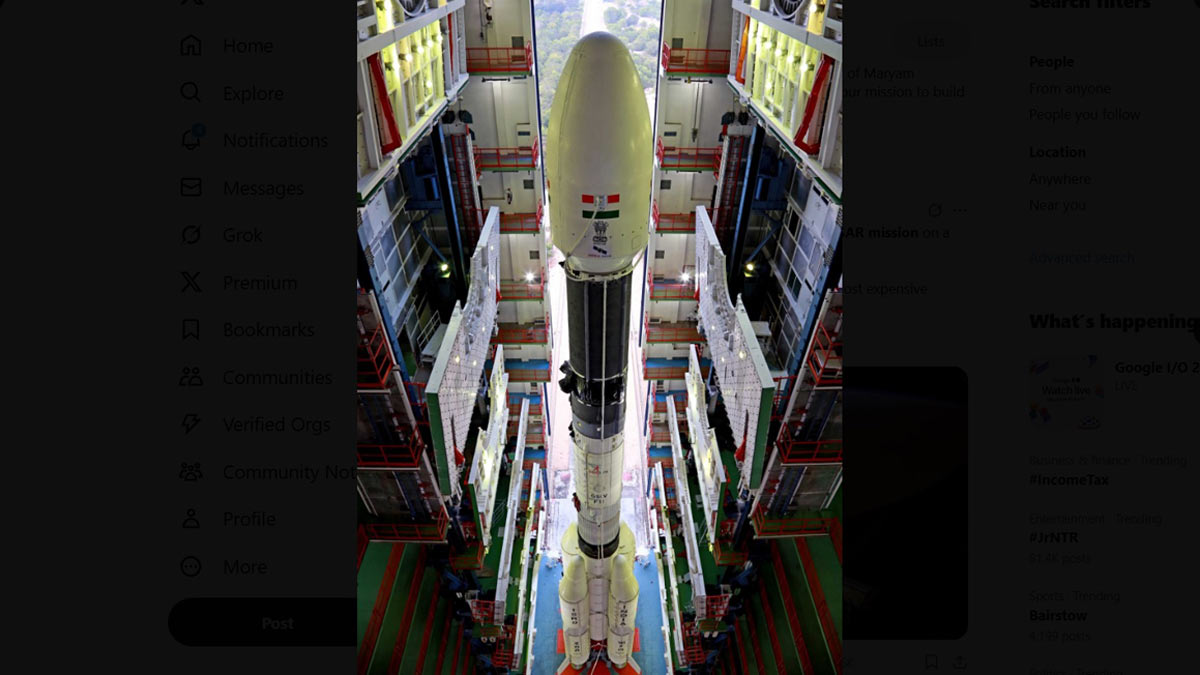Why ISRO chose GSLV for NISAR mission despite the launch vehicle's poor track record?

India’s space programme, led by the Indian Space Research Organisation (ISRO), relies heavily on two key rocket launchers—the Polar Satellite Launch Vehicle (PSLV) and the Geosynchronous Satellite Launch Vehicle (GSLV). While PSLV has a stellar track record, GSLV has faced multiple failures. Despite the few setbacks, GSLV is all set to launch the NASA-ISRO Synthetic Aperture Radar (NISAR) satellite in June 2025.
The PSLV has been more successful than the GSLV, but when it comes to NISAR, the latter is the preferred rocket.
Experts point out that PSLV is ISRO’s trusted champion because of its reliability. As of May 2025, PSLV has completed 63 launches. With 58 successes, three outright failures, and one partial failure, it has a success rate of about 92 per cent. Its first successful flight was in 1994, and it has launched 345 foreign satellites from 36 countries, besides Indian missions like Chandrayaan-1 and the Mars Orbiter Mission. PSLV’s four-stage design, alternating solid and liquid fuel stages, is straightforward and robust. The first stage (PS1) uses solid fuel with strap-on boosters, the second (PS2) uses liquid fuel (Vikas engine), the third (PS3) is solid, and the fourth (PS4) uses liquid engines for precise orbit placement.
“The design of the PSLV is easier to manage, and ISRO’s upgrades, like the PSLV-XL variant and a silicon carbide-coated nozzle tested in 2024, have boosted its payload capacity to 1,750 kg for Sun-synchronous polar orbits (SSPO). PSLV’s versatility for various orbits and cost-effectiveness make it a global favourite. However, its recent failure with EOS-09 shows even reliable systems can falter,” pointed out space expert Girish Linganna.
Meanwhile, GSLV has been less consistent, earning the nickname “naughty boy.” By October 2024, GSLV has completed 15 launches, with 9 successes, 4 failures, and 2 partial failures, yielding a success rate of about 60 per cent. The main issue is its cryogenic upper stage, which uses liquid hydrogen and oxygen at extremely low temperatures (-253°C and -183°C).
“The technology behind GSLV is tricky, and India’s journey to master it was tough. Early GSLV flights used Russian cryogenic engines, but after geopolitical hurdles in the 1990s, ISRO developed its own CE-7.5 engine for GSLV Mk II. Between 2001 and 2014, only two of the seven launches succeeded due to cryogenic stage issues. GSLV’s three-stage design—solid first stage, liquid second stage, and cryogenic third stage—is taller (51.7 meters) and heavier (420 tonnes) than PSLV, increasing its complexity. Recent successes, like the GSLV-F14/INSAT-3DS launch in 2024, show improvement, but its reliability lags behind PSLV,” explained Linganna.
The recent PSLV-C61 mission failure on May 18, 2025, carrying the EOS-09 satellite, marked ISRO’s 101st launch and PSLV’s third outright failure. This marks PSLV’s first failure since 2017 (PSLV-C39, heat shield issue) and only its third after PSLV-D1 (1993, software glitch). Despite this, PSLV’s long-term reliability remains strong, with four more launches planned for 2025.
So then, why has been the GSLV chosen for the NISAR mission despite its poor success rate? NISAR, a $1.5 billion NASA-ISRO collaboration, is a 2,800 kg Earth-observation satellite requiring a 747 km SSPO. Its weight exceeds PSLV’s capacity (1,750 kg to SSPO), but GSLV Mk II can handle up to 2,250 kg to Geosynchronous Transfer Orbit (GTO) and has the thrust for heavy payloads in polar orbits. GSLV’s cryogenic stage provides the precise boost needed for NISAR’s orbit. ISRO’s confidence in GSLV has grown with its last three successful launches, and the NISAR mission will use a new, eco-friendly C15 cryogenic stage introduced in 2024. Launching NISAR in June 2025 from Sriharikota is a strategic move to leverage GSLV’s capabilities for high-profile missions while PSLV handles lighter payloads.
GSLV’s selection for NISAR reflects ISRO’s push for advanced missions, as it phases out GSLV Mk II after eight launches, including NISAR, to focus on GSLV Mk III (LVM3), which can carry 4,000 kg to GTO. This transition shows ISRO’s ambition to balance reliability with innovation. But as experts point out, the PSLV’s success stems from its simple, versatile design and continuous upgrades, though the EOS-09 failure shows rare vulnerabilities. GSLV’s cryogenic challenges make it less reliable, but its power suits heavy missions like NISAR.
Sci/Tech